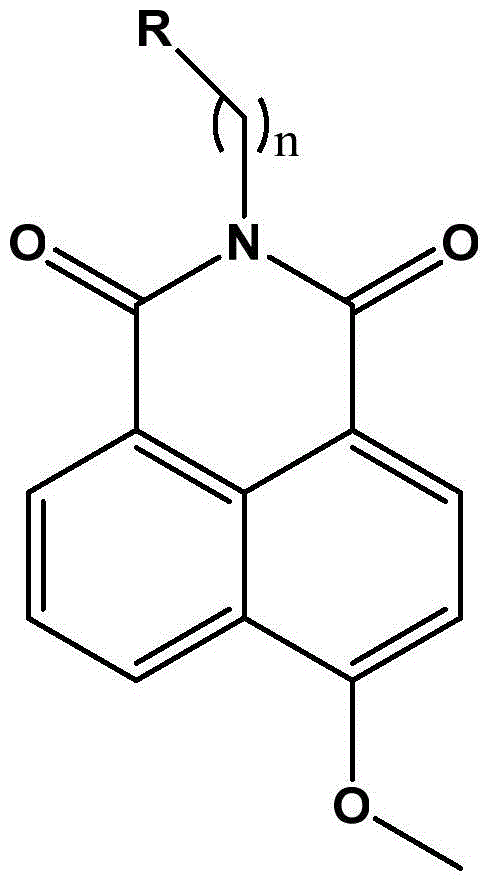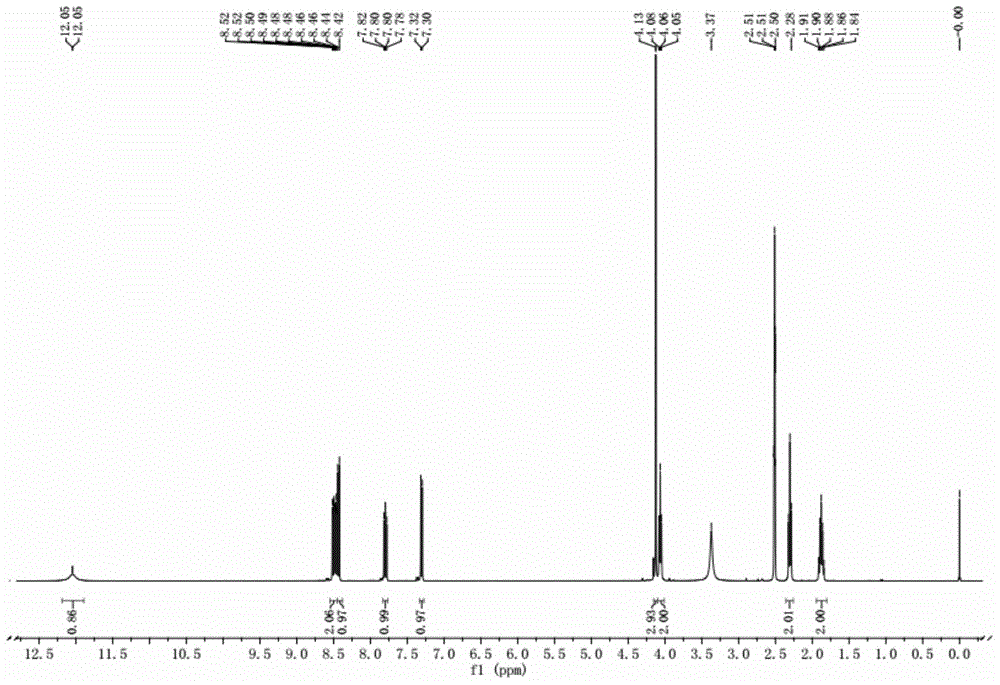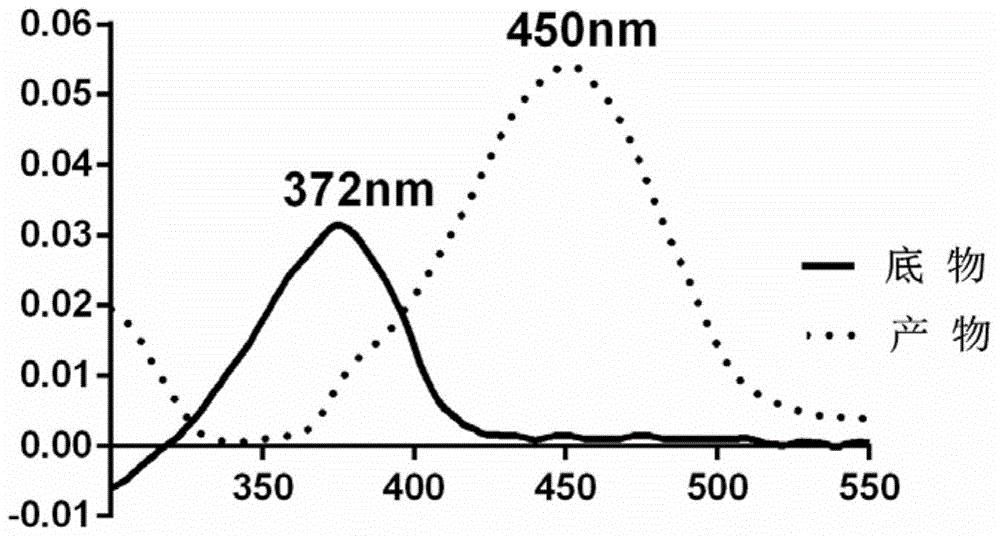Ratio type fluorescent probe substrate for cytochrome oxidase CYP1A and application thereof
A technology of cytochrome and fluorescent probe, applied in the field of ratiometric fluorescent probe reaction, can solve the problems of large quantitative error, interference of biological matrix, low selectivity of single enzyme, etc., and achieve simple synthesis process and low detection cost Effect
- Summary
- Abstract
- Description
- Claims
- Application Information
AI Technical Summary
Problems solved by technology
Method used
Image
Examples
Embodiment 1
[0038] Synthetic route of N-(3-carboxypropyl)-4-methoxy-1,8-naphthalimide
[0039] (1) Synthesis of compound 1
[0040] Add 4.2mmol of 4-aminobutyric acid to 50ml of ethanol solution containing 1g (3.61mmol) of 4-bromo-1,8 naphthalene anhydride, react overnight at 70-80°C, add 200ml of water, precipitate a large amount of solid, filter and dry in vacuo N-(3-carboxypropyl)-4-bromo-1,8-naphthalimide was obtained as a beige solid with a yield of 80-90%.
[0041] (2) Synthesis of compound 2
[0042] Put 800mg of compound 1 and 2.54g of potassium carbonate in a 100ml single-necked bottle, add 30ml of methanol, react at 60-70°C overnight, cool, adjust the pH to acidic with 1M hydrochloric acid, a large amount of yellow solid precipitates, filter, wash with a large amount of water, Vacuum drying gave N-(3-carboxypropyl)-4-methoxy-1,8-naphthalimide as a yellow solid with a yield of 80-90%.
[0043] The structures of compounds 1 and 2 are as follows Figure 9 As shown, the UV absor...
Embodiment 2
[0046] Synthesis of N-(carboxypentyl)-4-methoxy-1,8-naphthalimide
[0047] (1) Synthesis of compound N-(3-carboxypentyl)-4-bromo-1,8-naphthalimide
[0048] Add 4.2mmol of 6-aminocaproic acid to 50ml of ethanol solution containing 1g (3.61mmol) of 4-bromo-1,8 naphthalene anhydride, react overnight at 70-80°C, add 200ml of water, precipitate a large amount of solid, filter and dry in vacuo N-(3-carboxypentyl)-4-bromo-1,8-naphthalimide was obtained as a beige solid with a yield of 80-90%.
[0049] (2) Synthesis of compound N-(3-carboxypentyl)-4-methoxy-1,8-naphthalimide
[0050] Put 800mg of compound N-(3-carboxypentyl)-4-bromo-1,8-naphthalimide and 2.54g of potassium carbonate in a 100ml single-necked bottle, add 30ml of methanol, react overnight at 60-70°C, and cool , the pH was adjusted to acidic with 1M hydrochloric acid, a large amount of yellow solid was precipitated, filtered, washed with a large amount of water, and dried in vacuo to obtain yellow solid N-(3-carboxypent...
Embodiment 3
[0054] Synthesis of N-(4-carboxyphenyl)-4-methoxy-1,8-naphthalimide
[0055] (1) Synthesis of compound N-(4-carboxyphenyl)-4-bromo-1,8-naphthalimide
[0056] Add 4.2mmol of 4-aminobenzoic acid to 50ml of acetic acid solution containing 1g (3.61mmol) of 4-bromo-1,8 naphthalene anhydride, react overnight at 100-110°C, filter while hot, wash the filter cake with acetic acid, and dry in vacuo N-(4-carboxyphenyl)-4-bromo-1,8-naphthalimide was obtained as a beige solid with a yield of 30-40%.
[0057] (2) Synthesis of compound N-(4-carboxyphenyl)-4-methoxy-1,8-naphthalimide
[0058] Put 800 mg of compound N-(4-carboxyphenyl)-4-bromo-1,8-naphthoimide and 2.54 g of potassium carbonate in a 100 ml single-necked bottle, add 30 ml of methanol, and react overnight at 60-70 ° C, Cool, adjust the pH to acidic with 1M hydrochloric acid, precipitate a large number of yellow solids, filter, wash with water, and dry in vacuo to obtain yellow solid N-(4-carboxyphenyl)-4-methoxy-1,8-naphthalene...
PUM
 Login to View More
Login to View More Abstract
Description
Claims
Application Information
 Login to View More
Login to View More - R&D
- Intellectual Property
- Life Sciences
- Materials
- Tech Scout
- Unparalleled Data Quality
- Higher Quality Content
- 60% Fewer Hallucinations
Browse by: Latest US Patents, China's latest patents, Technical Efficacy Thesaurus, Application Domain, Technology Topic, Popular Technical Reports.
© 2025 PatSnap. All rights reserved.Legal|Privacy policy|Modern Slavery Act Transparency Statement|Sitemap|About US| Contact US: help@patsnap.com



